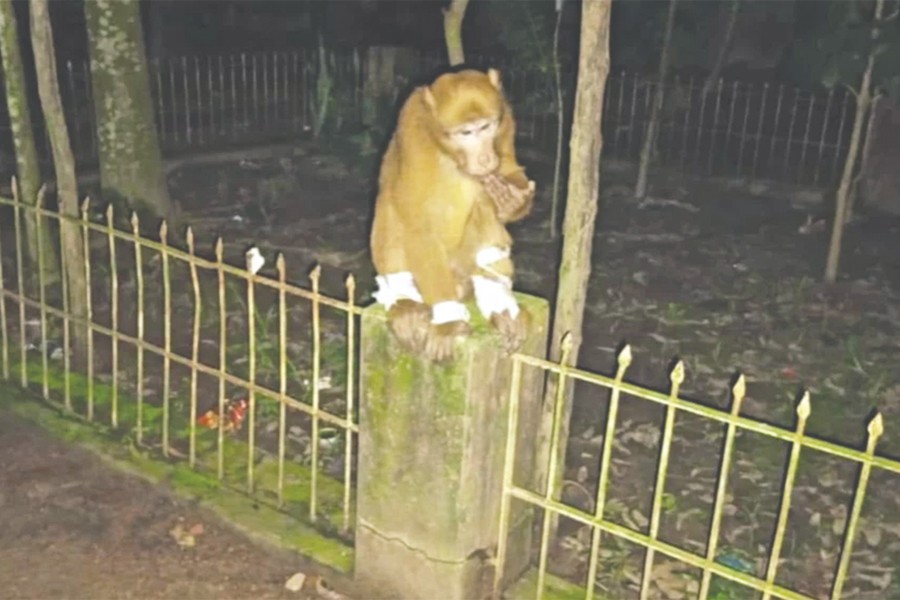
A CLOSE LOOK
The sad and sweet story of a monkey
Nilratan Halder | Saturday, 9 September 2023

It is a touching story of an injured monkey and quite unique at that. With deep wounds, reportedly from electric shock, an isolated member of the primate family arrives at Sitakunda Health Complex apparently for a redress. Fortunately for the injured primate, a doctor about to leave the health complex noticed the animal in distress at the gate looking so piteously. The doctor took pity on the animal that overcame its fear of human beings because of its extreme pain and suffering from the wounds all over its body. He dressed the monkey and during the dressing it remained calm and quiet. But the doctor knew the monkey needed veterinary intervention. So he contacted the upazila livestock officer and forest department officers requesting them to come and take it for proper treatment but no help was available.
The monkey appeared again next day with most of its dressing gone or coming off. Again, its wounds were dressed at the emergency room. Again, the doctor contacted the livestock officer and other authorities concerned but still there was no help from them. On the third day, the doctor noticed that the wounds were getting infected and this time he made fervent appeal to the livestock officer and others for saving the life of such an intelligent animal.
At last help came. The sad and sweet story culminates in placing the monkey in care of the Chittagong Veterinary and Animal Sciences University (CVASU) where surgery was done to cure its wound. Its condition stabilised after surgery done on it and there was sign that the monkey was well on course of recovery. But alas, it has not. On Friday at about noon, the primate breathed its last. It is a loss of a most cherished inter-species bond.
Non-human primates (NHPs) are also quite intelligent and can use sign language along with some tools. How this monkey could realise that the health complex is a centre for medical attention may not be known without study of primates' behaviour. But the monkey roaming about for a few days all around the area may have seen patients receiving treatment. Maybe, it has seen people with wounds getting dressed. This may have induced it to seek medical attention there. Indeed, its physical pain was so overwhelming that it had to look for its remission.
That the primates have developed faculties is clear from yet another incident that happened, coincidentally in September, 2019. A troop of hanuman langurs laid siege to Keshabpur police station in protest against torture of a baby ape. Its mother carried it on its shoulder and the rest followed to the police station and sat on the main entrance. Later they entered the duty officer's room. The officer-in-charge came down to see the troop of hanumans and gave them food. He was able to persuade them to vacate the police station by assuring that no such incident will happen in the future. Surely, the OC used human language but how the apes felt assured is not quite understandable to humans. But one thing is clear that the apes could appreciate this much that the police station is the proper place to lodge their complaint.
If the apes have shown such intelligence, this particular monkey also shares the innate quality of fellow feeling with the highest species among the primates. Indeed human beings have also not disappointed the wounded primate. They have taken good care of it. This is how man-animal relations should develop and prosper because every life is precious.
Man-wild animal relations in this part of the world, however, cannot be said to be very cordial. Although of late wild life conservation societies have come up with their network extending in different parts of the country, the overwhelming majority instinctively behave cruelly against birds and animals. Particularly those that are eatable only appeal to their omnivorous taste buds. As if every creature that moves on this planet is either for serving them in some way or making it to their dining table like the inquisitive cock in Sukanta Bhatacharya's poem!
It is heart-warming to know that young conservationists are coming up with a growing sense of love for and duty towards ailing creatures. Thus Himalayan vultures often becoming injured out of fatigue on their long journey are now rescued, treated and released after they become healthy again. There is a young man in Old Dhaka who treats injured kites and releases them when they get well. He also feeds a large number of those regular flying visitors from his rooftop. No wonder, his home is now known as Chil Bari (home of kites). Indeed, one of the pioneers of wildlife care is Sitesh Ranjan Dev of Sreemangal, Moulvibazar. The number of their young followers happily is growing. But there is a need for promoting the idea that all lives are sacred and have a place in the scheme of creation. Human beings must not act as the supreme predator simply because they have at their disposal the arsenals to do so.